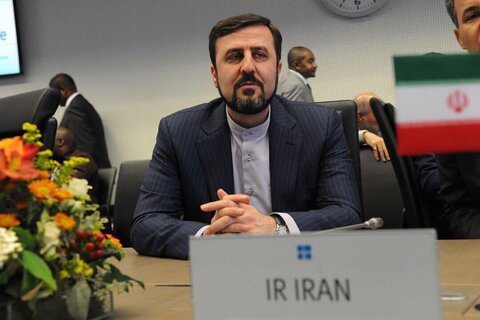Iran (IMNA) - Kazem Gharibabadi, Iran’s permanent representative to Vienna-based international organizations, told reporters on Wednesday that the new report shows the IAEA’s continued verification of the country's nuclear program.
According to the report, he said, in addition to heavy water production and storage, Iran has exported more than 2.2 tons of its heavy water and also utilized 1.3 tons in line with its research and development activities.
He said the report states that Iran has continued its uranium enrichment activities in Natanz and Fordow sites, using new machines, and enriching uranium up to 4.5% purity, which is beyond the 3.67% limit set in the nuclear agreement, which is officially known as the Joint Comprehensive Plan of Action (JCPOA).
In addition, he added, the report mentions Iran's recent decision to relocate its R&D centrifuges underground in Natanz and states that the country has declared it will consider safeguard requirements.
According to Gharibabadi, "the IAEA report has announced the amount of Iran's uranium reserves is about 2,442.9 kg as of November 2, which is equal to about 3,600 kg of low-enriched uranium."
He also pointed to the report's reference to the results of the IAEA's inspection of one of the country’s sites in 2018, and said that despite the differences in Iran’s technical views with the IAEA, interactions in that area are still ongoing between the two sides with the aim of resolving the issue.
Separately, Iran’s Ambassador to the United Nations Majid Takht-Ravanchi told a meeting of the UN General Assembly that Tehran believes the IAEA must fulfil its verification duty in a way that it does not overshadow the member states’ inalienable right to reinforce their peaceful use of nuclear energy.
Even the non-proliferation concerns should not limit the member states’ rights, he said, adding that the international community must reject any attempt to restrict peaceful use of nuclear energy.
He said over the past year, 22 percent of all the IAEA’s inspections have been carried out in Iran, and the watchdog’s activities have not stopped in the Islamic Republic even at the peak of the coronavirus outbreak.
Iran signed the JCPOA with six world states — namely the US, Germany, France, Britain, Russia and China — in 2015.
However, Washington’s unilateral withdrawal in May 2018 and subsequent re-imposition of sanctions against Tehran left the future of the historic agreement in limbo.
Iran remained fully compliant with the JCPOA for an entire year, waiting for the co-signatories to fulfill their end of the bargain by offsetting the impacts of American bans on the Iranian economy.
But as the European parties failed to do so, the Islamic Republic moved in May 2019 to suspend its JCPOA commitments under Articles 26 and 36 of the deal covering Tehran’s legal rights.
Iran took five steps in scaling back its obligations, among them abandoning operational limitations on its nuclear industry, including with regard to the capacity and level of uranium enrichment.
All those measures were adopted after informing the IAEA beforehand, with the agency's inspectors present on the ground in Iran.



Your Comment